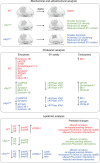Synaptic vesicle-omics in mice captures signatures of aging and synucleinopathy
- PMID: 40312501
- PMCID: PMC12046008
- DOI: 10.1038/s41467-025-59441-7
Synaptic vesicle-omics in mice captures signatures of aging and synucleinopathy
Abstract
Neurotransmitter release occurs through exocytosis of synaptic vesicles. α-Synuclein's function and dysfunction in Parkinson's disease and other synucleinopathies is thought to be tightly linked to synaptic vesicle binding. Age is the biggest risk factor for synucleinopathy, and ~15% of synaptic vesicle proteins have been linked to central nervous system diseases. Yet, age- and disease-induced changes in synaptic vesicles remain unexplored. Via systematic analysis of synaptic vesicles at the ultrastructural, protein, and lipid levels, we reveal specific changes in synaptic vesicle populations, proteins, and lipids over age in wild-type mice and in α-synuclein knockout mice with and without expression of human α-synuclein. Strikingly, we find several previously undescribed synaptic changes in mice lacking α-synuclein, suggesting that loss of α-synuclein function contributes to synaptic dysfunction. These findings not only provide insights into synaptic vesicle biology and disease mechanisms in synucleinopathy, but also serve as a baseline for further mechanistic exploration of age- and disease-related alterations in synaptic vesicles.
© 2025. The Author(s).
Conflict of interest statement
Competing interests: The authors declare no competing interests.
Figures







Similar articles
-
α-Synuclein in synaptic function and dysfunction.Trends Neurosci. 2023 Feb;46(2):153-166. doi: 10.1016/j.tins.2022.11.007. Epub 2022 Dec 23. Trends Neurosci. 2023. PMID: 36567199 Free PMC article. Review.
-
Synaptic vesicle binding of α-synuclein is modulated by β- and γ-synucleins.Cell Rep. 2022 Apr 12;39(2):110675. doi: 10.1016/j.celrep.2022.110675. Cell Rep. 2022. PMID: 35417693 Free PMC article.
-
Functional and Pathological Effects of α-Synuclein on Synaptic SNARE Complexes.J Mol Biol. 2023 Jan 15;435(1):167714. doi: 10.1016/j.jmb.2022.167714. Epub 2022 Jul 3. J Mol Biol. 2023. PMID: 35787839 Free PMC article. Review.
-
Increased expression of alpha-synuclein reduces neurotransmitter release by inhibiting synaptic vesicle reclustering after endocytosis.Neuron. 2010 Jan 14;65(1):66-79. doi: 10.1016/j.neuron.2009.12.023. Neuron. 2010. PMID: 20152114 Free PMC article.
-
Vesicle trafficking and lipid metabolism in synucleinopathy.Acta Neuropathol. 2021 Apr;141(4):491-510. doi: 10.1007/s00401-020-02177-z. Epub 2020 Jun 30. Acta Neuropathol. 2021. PMID: 32607605 Free PMC article. Review.
Cited by
-
Inverted day-night feeding during pregnancy affects the brain health of both maternal and fetal brains through increasing inflammation levels associated with dysbiosis of the gut microbiome in rats.J Neuroinflammation. 2025 May 2;22(1):130. doi: 10.1186/s12974-025-03447-x. J Neuroinflammation. 2025. PMID: 40317047 Free PMC article.
References
-
- Sudhof, T. C. The synaptic vesicle cycle. Annu Rev. Neurosci.27, 509–547 (2004). - PubMed
MeSH terms
Substances
Grants and funding
- R01NS126342/U.S. Department of Health & Human Services | NIH | National Institute of Neurological Disorders and Stroke (NINDS)
- 1R25GM152362/U.S. Department of Health & Human Services | NIH | National Institute of General Medical Sciences (NIGMS)
- R01 NS121077/NS/NINDS NIH HHS/United States
- OT2 OD030544/OD/NIH HHS/United States
- R01 AG052505/AG/NIA NIH HHS/United States
- R21AG085144/U.S. Department of Health & Human Services | NIH | National Institute on Aging (U.S. National Institute on Aging)
- R01 AG083949/AG/NIA NIH HHS/United States
- R21NS127939/U.S. Department of Health & Human Services | NIH | National Institute of Neurological Disorders and Stroke (NINDS)
- R21 NS127939/NS/NINDS NIH HHS/United States
- F31 NS125949/NS/NINDS NIH HHS/United States
- R25 GM152362/GM/NIGMS NIH HHS/United States
- R01NS095988/U.S. Department of Health & Human Services | NIH | National Institute of Neurological Disorders and Stroke (NINDS)
- UG3MH129381/U.S. Department of Health & Human Services | NIH | National Institute of Mental Health (NIMH)
- R01NS113960/U.S. Department of Health & Human Services | NIH | National Institute of Neurological Disorders and Stroke (NINDS)
- R21 AG085144/AG/NIA NIH HHS/United States
- R01NS136423/U.S. Department of Health & Human Services | NIH | National Institute of Neurological Disorders and Stroke (NINDS)
- RF1 NS126342/NS/NINDS NIH HHS/United States
- F31NS125949/U.S. Department of Health & Human Services | NIH | National Institute of Neurological Disorders and Stroke (NINDS)
- R01 NS113960/NS/NINDS NIH HHS/United States
- R01NS113960-02S1/U.S. Department of Health & Human Services | NIH | National Institute of Neurological Disorders and Stroke (NINDS)
- R01 NS136423/NS/NINDS NIH HHS/United States
- UG3 MH129381/MH/NIMH NIH HHS/United States
- R01NS121077/U.S. Department of Health & Human Services | NIH | National Institute of Neurological Disorders and Stroke (NINDS)
- R01 NS095988/NS/NINDS NIH HHS/United States
- U2C DK119886/DK/NIDDK NIH HHS/United States
LinkOut - more resources
Full Text Sources
Medical
Molecular Biology Databases

